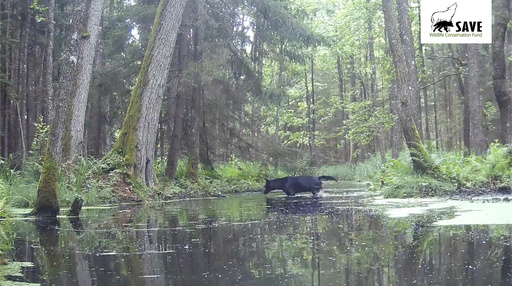WARSAW, Poland — A remarkable sighting of two rare black wolves, thought to be siblings, was captured by a camera in a Polish forest, according to a conservation group statement made on Sunday.
The footage, recorded last year by Joanna Toczyd?owska, the project coordinator for the SAVE Wildlife Conservation Fund in Poland, has sparked interest among researchers who are now collecting scat samples in the area to investigate the genetics of these elusive black wolves.
“This is a novel and extraordinary occurrence,” Toczyd?owska remarked.
Originally, the camera was set up to observe beavers, but upon discovering the wolves on the recording, she redirected her efforts to monitor these fascinating creatures. Just a few weeks ago, she was able to secure footage of the black wolves in action.
In one particular segment, a black wolf and a gray wolf are seen cautiously wading through a stream, with the water nearly reaching their bellies before they leap onto the shoreline. A different clip from last fall reveals two black wolves accompanied by a gray wolf, all navigating the same stream.
In Poland, the majority of the estimated 2,500 to 3,000 wolves are gray, often with red or black markings. The black coloring occurs due to a genetic mutation that has likely been present in domesticated dogs for thousands of years. This dark fur is uncommon in Europe due to a decrease in genetic variation, although in Yellowstone National Park in the U.S., over half of the wolf population boasts a black coat.
Given the family-oriented nature of wolves and the fact that both black wolves weigh approximately 30 kilograms (66 lbs) — similar to a German Shepherd — Toczyd?owska believes they are likely siblings and around one year old, with at least one being male.
To protect these wolves from the threat of poaching and to curb the spread of misleading information regarding their presence, the conservation group has opted not to disclose the specific location of the forest.
Wolves in Poland faced almost complete extinction by the 1950s; however, their numbers have seen a rebound in recent years, particularly in the central regions of the country since the early 2000s. Toczyd?owska and her team actively engage with the public to provide education on how to coexist safely with wolf populations.
“This is a new experience for many people,” Roman Gula, who leads the organization’s wolf monitoring project, explained. “Education remains one of our primary objectives.”
Last week, the conservation fund shared the news of the sighting on their social media page and appealed for financial assistance to cover the genetic testing of the collected scat samples, hoping to gain further insight into the black fur mutation.
Copyright @2024 | USLive | Terms of Service | Privacy Policy | CA Notice of Collection | [privacy-do-not-sell-link]


